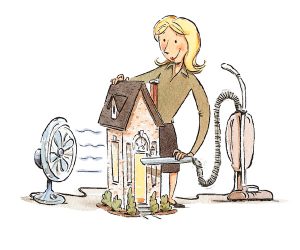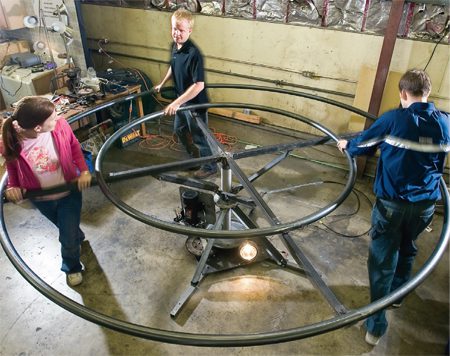 By Maribeth Christensen Clarke, ’80, and Carolyn L. Garrison, ’70
By Maribeth Christensen Clarke, ’80, and Carolyn L. Garrison, ’70
Cleaning the air at home can solve at host of common health problems.
In today’s industrial society we all worry about pollution clouding our skies and dirtying the air we breathe. But what many of us don’t know is that we can’t necessarily escape the danger of air pollution simply by going indoors. Indoor air pollution can be just as bad as—or worse than—outdoor air pollution and can cause problems ranging from mild annoyances to severe illnesses or even death. A common and increasing problem brought on or aggravated by indoor air pollution is children’s asthma, a chronic inflammation in the lungs that causes wheezing and shortness of breath.
Ironically, some of the techniques invented to increase a home’s energy efficiency are major contributors to indoor pollution. Some cheaper, more effective textiles and building products emit potentially irritating gases. In addition, homes that are nearly airtight limit the exchange between outdoor and indoor air, trapping indoor pollutants. To make matters worse, most of us spend more than 90 percent of our time indoors. Although most new homes built today use safer materials and have better air filtration systems, many people live in older homes or don’t properly maintain the quality of their home’s air. By checking your home for sources of indoor air pollution, you can begin eliminating potential causes of distress for your family.
Living Pollutants
Some triggers of asthma, allergies, and other indoor pollution–related problems are biological contaminants in the home, including dust mites, molds and mildews, animal dander (scales from hair, feathers, and skin), and cockroach droppings and body parts. Older and poorly kept homes are prime residences for some of these allergens. Mold and mildew are particularly common in humid areas, and leaky roofs, windows, walls, foundations, and plumbing fixtures welcome opportunistic molds. Microscopic dust mites, which thrive on dead human skin cells and live in household textiles, are another group of troublemakers. When these textiles are disturbed, dust particles become airborne. Dust mites are especially prevalent in homes with dirty air conditioning, dehumidifiers, or ventilation systems, or with no air-circulation system at all.
You can kill, or at least control, these bugs and molds through regularly cleaning your house. Frequently dusting furniture, vacuuming carpets and upholstery, and washing bedding in hot water will help, as will finding new homes for allergy-inducing plants and pets. Vacuum carpets twice a week and upholstery and mattresses twice a month and have certified professionals clean carpets and upholstery twice a year. Pets’ areas should be cleaned and vacuumed daily to weekly. Hard surfaces should be cleaned and disinfected daily to weekly, depending on location and use.
Improved air-filtration systems for use in furnaces, air conditioners, and vacuum cleaners do wonders to control exposure to biological contaminants. In fact, high-efficiency particulate-arresting (HEPA) air filters on air purifiers and vacuum cleaners remove more than 95 percent of all pollen, mold spores, animal dander, dust mites, bacteria, smoke particles, and dust from the air they process. Vacuum cleaners with multi-stage filtration systems and double-wall, disposable inner bags are helpful, especially if the bag is changed when only half full. A central vacuum system, which doesn’t expose the user to the collected dust, is a good way to steer clear of allergens.
Lead Dust
Children living in older homes are at a high risk for ingesting lead-contaminated dust or paint chips. Lead was used in house paint until 1978 as a pigment and drying agent. Today an estimated 74 percent of homes in the United States have some lead-based paint. For years lead was also used in plumbing and fixture melding. Many homes with older plumbing have lead traces in the drinking water.
Small amounts of lead dust can accumulate in the body over time; its effects are irreversible. In young children, lead build-up in the body attacks the central nervous system and can cause delayed development, specifically manifested in reading and learning problems, lower IQ, hyperactivity, and discipline problems. Large doses of lead can cause high blood pressure, anemia, and kidney and reproductive disorders in children and adults. Untreated lead toxicity can cause convulsions, coma, and even death.
Lead paint in good condition is not a threat to your family and should be left alone. Peeling and cracked paint, however, should be tested for lead with kits available at home centers or through professional detection services. Lead paint is best removed by a professional. In the meantime, good housekeeping and sanitation practices, such as damp mopping floors and frequently washing your children’s hands and toys, can lower your family’s risk.
Volatile Organic Compounds
Formaldehyde, a preservative and adhesive, is used widely in the building and home-furnishing industries. Formaldehyde is found in particleboard, carpet, plywood, laminated furniture, cabinets, and some permanent-press fabrics. Formaldehyde and other volatile organic compounds (VOCs), found in paints, varnishes, carpets, and furniture, emit potentially harmful gases. High humidity and temperatures increase these emissions. Emissions from dry-cleaned or permanent-press clothing, along with perfume (in which formaldehyde is used as a preservative), can also create a toxic indoor air environment.
Those sensitive to formaldehyde and VOCs commonly complain of headaches, watery eyes, and burning nose, throat, and eyes. Choosing products labeled as being low in formaldehyde and otherVOCs will help keep emissions down. Also, keeping your house well ventilated is important when new sources of formaldehyde or other VOCs are brought inside. These emissions generally decrease as products age.
Radon Gas
Radon is an invisible, odorless, and radioactive gas created from the natural breakdown of uranium in soil and rock. Some areas have high amounts of radon; others have little or none. Radon is a health concern because it continues to decay into solid radioactive elements. These elements attach to dust in the air and can be inhaled. Radon can also contaminate groundwater and be inhaled with steam from bathroom showers. The Environmental Protection Agency (EPA) estimates that radon may be a factor in thousands of cancer cases and related deaths each year.
Today new homes often include radon-resistant features such as vents that allow radon gas beneath the foundation to be released into the atmosphere. The energy-efficient homes of the 1950s–1990s were not built with radon-venting features. As a result, radon gas can seep through cracks in the foundation and build up inside such houses. An estimated one out of every 15 homes in the United States has radon levels above the EPA‘s recommended action level. Houses built before the 1950s generally are not at risk because they are not as airtight.
The local or state public health department can tell you whether radon levels are a concern in your area. You can monitor radon levels in a house using a home detection kit or by hiring a radon monitoring service. Radon levels vary over time, so long-term testing is important. Also, be sure to seal cracks in foundation floors and walls and remove groundwater that seeps into your basement.
Asbestos
Asbestos, a naturally occurring mineral fiber, was used extensively in thousands of household products until the 1970s for its strength as well as its acoustical insulation, fireproofing, and thermal properties. Asbestos was added to flooring, ceiling spackle, roofing, siding, pipes, ducts, walls, gaskets, soundproofing, and appliances.
For all its useful qualities, however, asbestos has been found to cause several potentially fatal diseases, including cancer. Symptoms from exposure to asbestos are sometimes not noticed until 20 to 30 years after the initial exposure. The greatest potential for asbestos exposure is in homes built before the 1980s or in homes that have older household products.
Asbestos products in good condition are usually best left alone. Covering, painting, or repairing some deteriorating asbestos products is a way to lower your risk. Asbestos removal is dangerous and should be done only by a trained professional.
Household Products
Be wise in your choice and use of household products. Pesticides, cleansers, solvents, preservatives, repellents, fresheners, and fuels are all products that can cause health problems if used improperly. Use household products only for their intended purposes, in well-ventilated areas, and according to manufacturers’ directions.
Indoor air pollution can exist in any home but can be minimized by eliminating sources of pollution and having proper ventilation, air filtration, and cleanliness. By understanding the factors affecting indoor air quality and learning how to control them, you can make your home a safer and more comfortable place to live.
Maribeth C. Clarke is an associate professor of family life and home economics education. Carolyn Garrison is an assistant professor of family life and home economics education.
This article is adapted from “Do You Need to Clean the Air?” (Marriage and Families [August 2001, pp. 9–15]), and is used by permission. (See marriageandfamilies.byu.edu.)
More information about indoor air quality can be found at the following organizations’ Web sites:
* Allergy and Asthma Network/Mothers of Asthmatics: aanma.org
* American Lung Association: lungusa.org/air/air_indoor_redux2.html
* Consumer Product Safety Commission: www.cpsc.gov/cpscpub/pubs/iaq.htm
* Environmental Protection Agency: epa.gov/iaq
* Federal Consumer Information Center: pueblo.gsa.gov/cic_text/housing/indoorair-hazards/main.htm
correction: BYU Magazine failed to attribute “Creating Harmony”(winter 2001, pp. 56–57), by E. Jeffrey Hill, ’77, to “Harmonizing Work and Family Life: One Man’s Perspective” (Marriage and Families [April 2001, pp. 2–6]), from which it was adapted.









